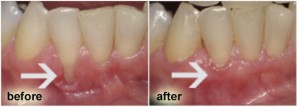By Arthur Kezian
Gum disease, especially gum recession, is a common problem identified by your dentist. Often people are unaware of the disorder because it can be asymptomatic and the process is typically gradual. Identification of the issue is important because receding gums may be a sign of more serious periodontal disease.
Dr. Kezian is extremely knowledgeable about the causes of gum recession, ways to prevent it and different treatment options.
What Is Gum Recession?

Where the gum and tooth meet is called the gum line. Receding gums simply refers to the process in which the gum line pulls back. The result is more tooth exposure. The gaps between teeth often enlarge as well. This increases the area in which bacteria can grow and plaques can form. Ultimately, you are at an increased risk for the development of dental caries and, in worst case scenario, tooth loss. The presence of gum recession is often the very first sign of gum disease.
What Are Other Causes Of Gum Disease?
As mentioned above, periodontal disease is typically the culprit for gum recession. What else can cause this? Believe or not, brushing your teeth too aggressively can irritate the gums and lead to recession! If there is excessive force placed on the teeth and gums due to teeth clenching or grinding or irregularities in your bite such as crooked teeth can lead to gum recession too. Tobacco use also leads to a higher rate of gum recession.
How Do You Treat Gum Recession?
Now that the problem of gum recession has been identified, your dentist needs to identify the cause in order to dictate the treatment plan. If the disease is only due to mild gum disease, a good deep cleaning of the affected area while at the dentist with extra care given in your routine dental care should reverse the process. This deep cleaning process is also referred to as tooth scaling and root planning. Below the gum line and not visible to you, plaque and tartar may have built up. Basically the dentist “deeply” cleans under the gum line, removes the irritating plaques and then planes or smoothes the surface so that in the future, bacteria cannot attach so easily. Many times you will receive a course of oral antibiotics as well to rid your mouth of any remaining harmful bacteria.
Of course if a misaligned jaw or crooked teeth has caused your gum disease this needs to be corrected.
 If the gum recession is severe, such as excess loss of bone or deep pockets between the teeth, a deep cleaning may not do the trick. If this is the case, gum surgery may be your only option. This often involves a tissue graft. Basically a small piece or flap of skin is removed from the hard palate in your mouth and relocated or grafted to the area with the exposed root.
If the gum recession is severe, such as excess loss of bone or deep pockets between the teeth, a deep cleaning may not do the trick. If this is the case, gum surgery may be your only option. This often involves a tissue graft. Basically a small piece or flap of skin is removed from the hard palate in your mouth and relocated or grafted to the area with the exposed root.
How Do You Prevent Gum Disease?
Of course, the best treatment is prevention! Here are some good habits that can lower your chances of developing gum disease. Make sure you are practicing good oral hygiene that includes, brushing at least two times a day with a soft bristled toothbrush, and adding flossing to your dental regimen. Lifestyle changes such as tobacco cessation are important as well.
Remember gum recession should not be ignored. Dr. Kezian, can repair the effects of gum disease and prevent further progression.
Dr. Arthur A. Kezian DDS 443 N. Larchmont Blvd Los Angeles, CA 90004 (323) 467-2777
